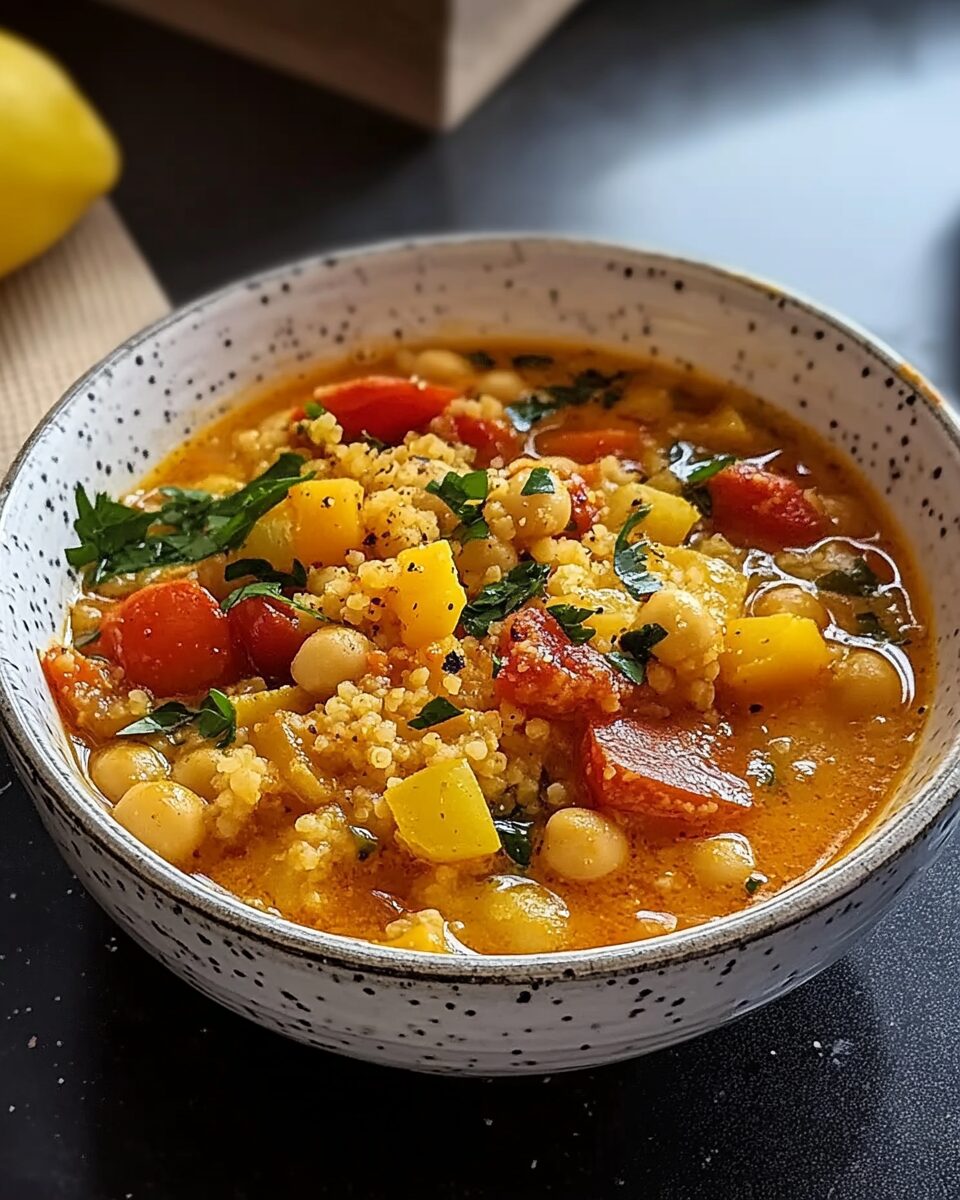Harira is a traditional Moroccan soup celebrated for its rich, hearty, and aromatic qualities. This vegetarian version combines a robust blend of tomatoes, chickpeas, lentils, and an array of spices, offering a delightful taste of Moroccan cuisine. Often enjoyed during Ramadan to break the fast, harira is cherished for its nourishing and comforting properties.
Full Recipe:
Ingredients
For the Soup:
- 2 tablespoons olive oil
- 1 large onion, finely chopped
- 2 celery stalks, diced
- 2 carrots, peeled and diced
- 3 cloves garlic, minced
- 1 (14.5 oz) can diced tomatoes
- 1 (15 oz) can chickpeas, drained and rinsed
- 1 cup dried lentils, rinsed
- 6 cups vegetable broth
- 1 teaspoon ground turmeric
- 1 teaspoon ground cumin
- 1 teaspoon ground cinnamon
- 1 teaspoon ground ginger
- 1 teaspoon paprika
- 1/2 teaspoon ground black pepper
- Salt to taste
- 1/2 cup fresh cilantro, chopped
- 1/2 cup fresh parsley, chopped
- Juice of 1 lemon
- Optional: 1/2 cup cooked rice or broken vermicelli pasta
For the Thickening Slurry:
- 1 tablespoon all-purpose flour
- 1 large egg
- 1 tablespoon lemon juice
- 2 cups water
Directions
-
Sauté Vegetables: In a large pot, heat olive oil over medium heat. Add chopped onions, celery, and carrots. Cook until softened, about 5-7 minutes. Stir in minced garlic and cook for another minute until fragrant.
-
Add Tomatoes and Spices: Add diced tomatoes to the pot along with turmeric, cumin, cinnamon, ginger, paprika, black pepper, and salt. Stir to combine and cook for 5 minutes, allowing the spices to toast and the tomatoes to break down.
-
Incorporate Legumes and Broth: Add chickpeas, lentils, and vegetable broth to the pot. Bring the mixture to a boil, then reduce heat to low. Cover and simmer for about 30-40 minutes, or until lentils are tender.
-
Prepare the Thickening Slurry: In a separate bowl, whisk together flour, egg, lemon juice, and water until smooth.
-
Thicken the Soup: Slowly pour the slurry into the simmering soup, stirring constantly. Continue to cook for an additional 10 minutes, allowing the soup to thicken to a hearty consistency.
-
Add Greens and Final Seasoning: Stir in chopped cilantro, parsley, and lemon juice. Adjust salt and pepper to taste. If desired, add cooked rice or pasta at this stage.
-
Serve: Ladle the soup into bowls and garnish with additional cilantro and parsley. Serve warm with crusty bread or pita.
Nutritional Facts (per serving, based on 6 servings)
- Calories: Approximately 320 kcal
- Total Fat: 8g
- Saturated Fat: 1g
- Cholesterol: 55mg
- Sodium: 800mg
- Total Carbohydrate: 50g
- Dietary Fiber: 12g
- Sugars: 8g
- Protein: 14g
- Vitamin A: 120% DV
- Vitamin C: 25% DV
- Calcium: 6% DV
- Iron: 20% DV
The Origins of Harira
Harira is a quintessential dish in Moroccan cuisine, and its origins date back centuries. It is often associated with Ramadan, where it is served to break the fast at sunset. Traditionally, the soup was made with lamb or beef, but vegetarian versions have become increasingly popular due to dietary preferences and the desire for lighter, plant-based options. Harira is considered a nourishing and revitalizing dish because of the way it combines protein-rich legumes like chickpeas and lentils with fresh vegetables, making it perfect for replenishing energy after a long day of fasting.
In Morocco, Harira is a symbol of hospitality and generosity. It is frequently served at family gatherings, celebrations, and social events, where it is shared with loved ones and guests. It is often accompanied by dates, bread, and a refreshing drink, making it part of a larger communal meal. The soup is commonly served with a squeeze of lemon, which enhances its flavor and adds a zesty contrast to the richness of the broth. Over time, Harira has transcended regional boundaries and has become a beloved dish throughout Morocco and beyond. Variations of the soup can be found in neighboring countries, with slight differences in ingredients and preparation methods. Whether served as part of a festive meal or as a comforting weeknight dinner, Harira remains a cherished dish that showcases the best of Moroccan culinary traditions.
Health Benefits of Vegetarian Moroccan Harira
One of the standout features of Vegetarian Moroccan Harira is its nutritional value. The soup is packed with plant-based protein, fiber, and a variety of essential vitamins and minerals. It is a complete meal that provides a balanced combination of carbohydrates, protein, and healthy fats, making it both filling and satisfying.
The fresh herbs, such as cilantro and parsley, that are added to Harira not only enhance the flavor but also offer a range of health benefits. These herbs are rich in antioxidants and anti-inflammatory compounds that help to support the immune system, reduce inflammation, and promote overall well-being. The lemon juice added at the end provides a refreshing burst of vitamin C, which is essential for immune function and skin health. Additionally, the spices used in Harira, such as turmeric, cumin, cinnamon, and ginger, are not only flavorful but also known for their health benefits. Turmeric, in particular, contains curcumin, a powerful anti-inflammatory compound that has been shown to support joint health and reduce the risk of chronic diseases. Cumin and ginger are also known for their digestive benefits and have been used in traditional medicine to support digestion and relieve discomfort.
The Rich Flavor Profile of Harira
One of the most remarkable aspects of Vegetarian Moroccan Harira is its complex and rich flavor profile. The soup is a delightful combination of savory, tangy, and aromatic elements that come together in perfect harmony. The base of the soup is made with onions, carrots, and celery, which provide a savory foundation for the rest of the ingredients. The tomatoes add a tangy sweetness that balances out the richness of the legumes and spices.
The spices used in Harira are what truly set it apart. The warm, earthy flavors of cumin, turmeric, cinnamon, and ginger create a depth of flavor that is both comforting and invigorating. These spices are commonly used in Moroccan cooking and are known for their ability to enhance the natural flavors of vegetables and legumes. The addition of paprika adds a mild smokiness to the soup, while the black pepper gives it a subtle kick.
Customizing Your Harira
One of the great things about Vegetarian Moroccan Harira is its versatility. While the recipe offers a base of vegetables, legumes, and spices, there is plenty of room for customization based on your personal preferences or dietary needs. For example, if you prefer a heartier soup, you can add additional vegetables such as zucchini, spinach, or bell peppers. If you enjoy a bit of heat, you can add a pinch of cayenne pepper or a chopped chili pepper to the soup for an extra kick.
If you’re looking to add more protein, you can incorporate other legumes like beans or peas, or even add a handful of quinoa or couscous to make the soup more filling. Some variations of Harira also include rice or vermicelli pasta, which adds texture and substance to the soup. These additions can make the soup even more satisfying and can help stretch the recipe to serve more people.
Serving Harira
Harira is traditionally served as a starter or main course in Moroccan households. It is often enjoyed during special occasions, family gatherings, and festive meals. The soup is typically served with dates, bread, or pita on the side, which can be used to dip into the soup and soak up its delicious flavors. To make the meal even more special, consider serving Harira with a simple Moroccan salad made with fresh vegetables, olives, and a tangy dressing. A side of couscous or rice can also complement the soup and turn it into a more substantial meal.
Conclusion
Fresh sweet corn fritters are a delicious, easy-to-make dish that brings together the natural sweetness of corn with the satisfying crunch of a fried snack. Whether served as an appetizer, side dish, or light main course, these fritters are sure to be a hit at any gathering. The combination of fresh corn, simple ingredients, and a crispy exterior makes this dish a versatile favorite that’s perfect for a variety of occasions.

